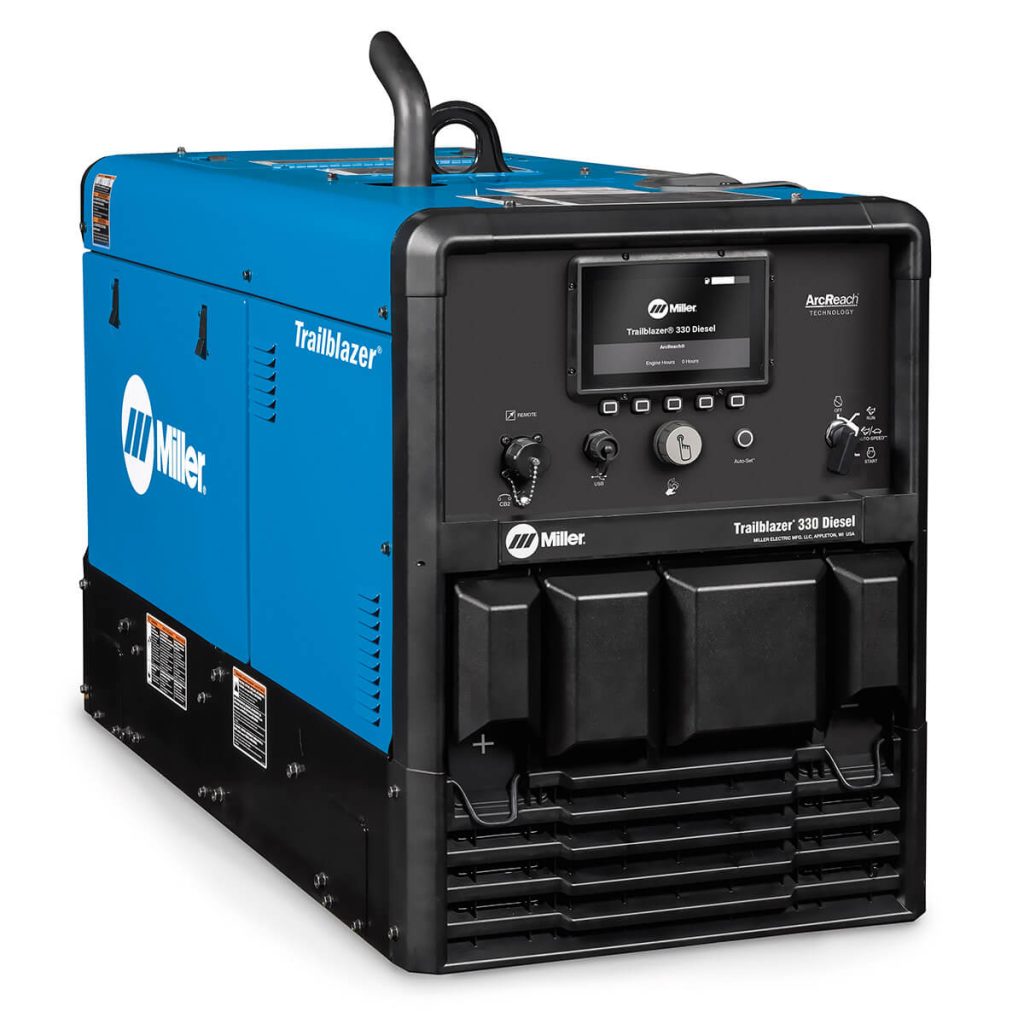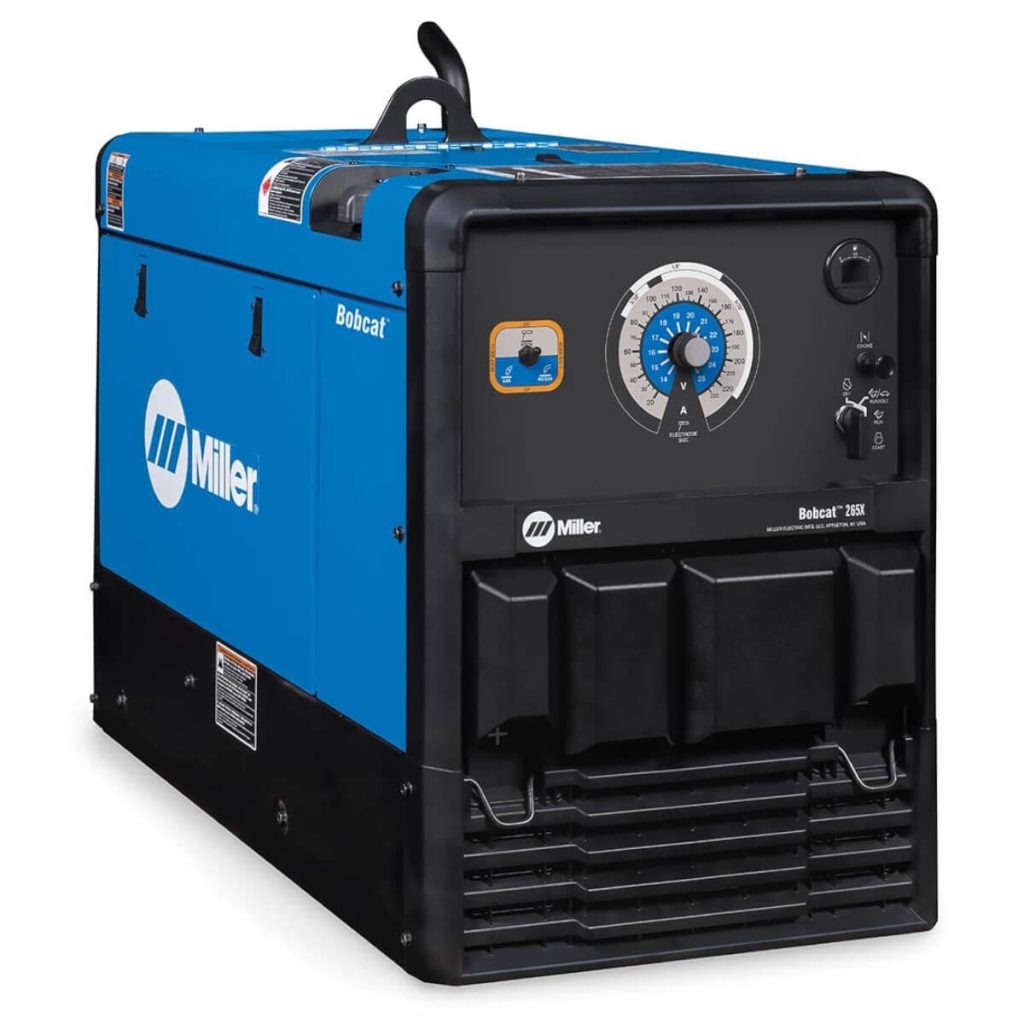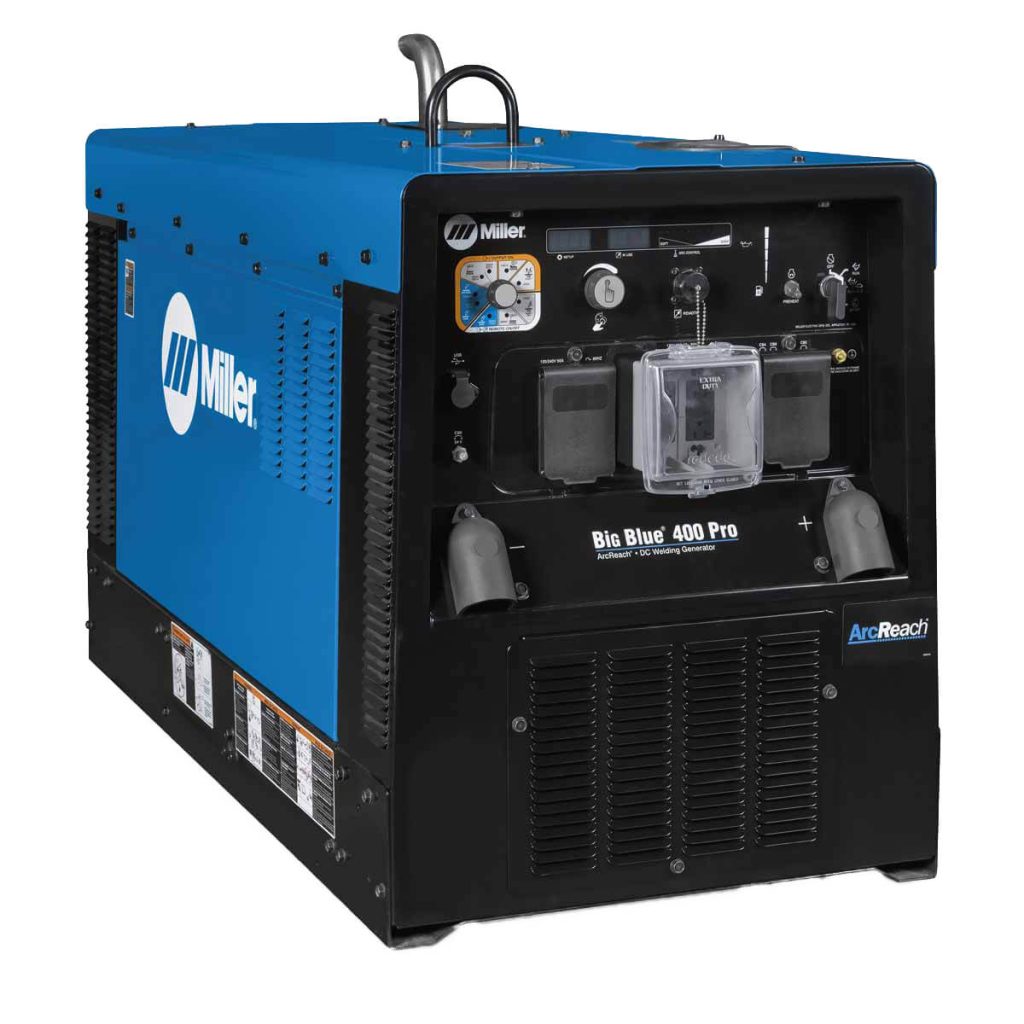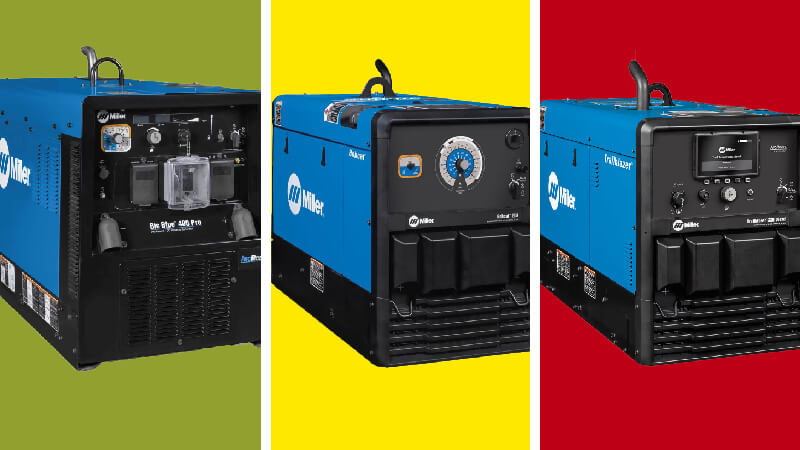If you are thinking on getting an engine-driven welder in 2024 is because you run some serious welding operations. Defining what engine-driven welder you are going to get is an important decision, because they are expensive equipment, designed to last for many years, in harsh conditions, with low maintenance. In this regard, there are way more factors to take into account besides pricing.
In this article we are going to consider 3 engine-driven welders. Each one have versions, meant for specific taks. Feel free to contact us to dig deeper on any of these models.
Before getting into detail, let’s see first what are the main uses of engine-driven welders.
Main uses of engine driven welding machines
An engine-driven welder is a portable welding machine that uses a gasoline or diesel engine to power the welding arc. They are typically used in situations like the following ones:
Lack of power: There is no access to electricity or the available electrical supply is not sufficient to power an electric welder. Engine-driven welders generate their own power so can operate without being plugged into an electrical outlet.
Portability and mobility are required: An engine-driven welder sits on its own trailer or wheels so it can be easily moved around a job site or between locations. This makes it useful for construction sites, farms, remote areas, and applications where the welding needs to be done in different spots.
High power output is needed: Engine-driven welders are capable of providing a very high electrical output, often over 10,000 watts. This makes them well-suited for heavy duty welding jobs on thick materials that require more amperage.
Extended running time is necessary: Since engine-driven welders have an onboard fuel supply and generate their own power, they can operate for very long periods without stopping as long as they have fuel. This makes them a good choice when a lot of long, continuous welds are required.
Where engine driven welding machines are needed
There are a few places and job sites where it is clear the need for engine-driven welders.
Construction sites: Engine-driven welders are essential for construction work, as they can be used to weld steel beams, pipes, and other metal components. In these job sites mobility is esential.
Farms and ranches: Farmers and ranchers often need to weld fences, gates, and other equipment, and engine-driven welders are ideal for these tasks.
Maintenance and repair work: Engine-driven welders can be used for a variety of maintenance and repair tasks, such as welding on cars, trucks, and other machinery.
Disaster relief: Engine-driven welders are often used in disaster relief efforts, as they can be used to repair damaged infrastructure and equipment. In these areas usually there is no access to power.
3rd place: Miller Trailblazer 330
The Miller Trailblazer 330 is a reliable engine-driven welder with unbeatable arc performance. It provides the smoothest and most stable arc in the industry. Trailblazer exclusive technologies, like advanced Auto-Speed and optional Excel power, deliver superior runtimes, increase fuel efficiency, and improve engine-driven welder performance.
No other engine-driven welder in the 300-amp class delivers more welding power or more auxiliary power with better fuel efficiency and less noise, for productive, profitable, and quieter jobsites.
This machine comes in 2 versions: Diesel and Gasoline (wirh a Kohler engine).

Highlights of the Miller Trailblazer 330
Processes
- Air Carbon Arc Cutting and Gouging (CAC-A)
- Flux Cored (FCAW)
- MIG (GMAW)
- Pulsed TIG (GTAW-P)
- Stick (SMAW)
- TIG DC (GTAW-DC)
Industries Interests
- Construction and Fabrication
- Heavy Equipment
Weldable Metals
- Aluminum
- Stainless Steel
- Steel
Portability
- Lift Eye (Standard)
- Running Gear / Cart (Optional)
- Trailer (Optional)
Applications
- Aluminum Welding
- Fabrication
- Field Welding
- Industrial Welding
- Mobile Fabrication & MRO
- Structural Welding
Technical Specifications
- Amperage: 20 A – 330 A
- Rated Carbon Diameter: 1/4 in (6.4 mm)
- Current Type: DC
- Max Open Circuit Voltage: 107 VDC
- Engine Idle Speed: 2400 RPM
- Engine Weld Speed: Advanced Auto-Speed (TM) technology: Varies engine speed from 2,400-3,600 rpm to match weld output
- Fuel Tank Size: 11 Gallon
- Horsepower: 23.5 hp
- Weld Output: CC / CV
- Rated Output: CC/DC Stick/TIG 330 A at 30 V, 100% duty cycle, CV/DC MIG/FCAW 325 A at 30.25 V, 100% duty cycle
- Single Phase Auxiliary Continuous Power: 10500 W
- Single Phase Auxiliary Peak Power: 12000 W
- Sound Rating: 65 dB @ idle and 73.5 dB @ max weld
A few details about the Miller Trailblazer 330
Easy to Use: Digital interface speeds machine setup and makes it less complicated.
Exceptional Arc Performance: Easy arc starts and less spatter.
Easy Maintenance: With its intuitive design, the daily maintenance of our Trailblazer engine-driven welder is fast and easy.
Mobility: Easier mobility and uses less truck space and payload. Over 80 pounds lighter and 13 percent smaller than previous models.
Auto-Speed technology: Advanced Auto-Speed technology automatically adjusts engine speed to match weld and battery charge demands, reducing fuel consumption, maintenance costs and noise for a safer, more efficient job site.
Separate weld and auxiliary power: Full auxiliary power at any setting.
ArcReach Technology: ArcReach technology uses existing weld cables to communicate process adjustment commands back to the engine-driven welder. With an ArcReach system, amperage & voltage are conveniently located at the operator’s fingertips, not back at the power source.
Dynamic DIG: Unlike conventional DIG that provides a preset amount of short-clearing current, Miller’s proprietary Dynamic DIG works on a time-based algorithm that automatically adjusts the amount of current required to clear a short. This results in a smoother more consistent arc that can be tailored to match application, material, fit up, and welder technique.
QuietPulse: This is activated by changing the waveshape for DC pulse welding, creating a slower, more fluid transition between the background and peak amperage to create the least possible audible noise.
2nd place: Miller Bobcat 265X
The Miller Bobcat 265X is a reliable, easy to use and more capable engine-driven welder great for stick and flux-cored welding. Designed for maintenance and repair operations, construction, farm, ranch and auxiliary power use.

Highlights of the Miller Bobcat 265X
Processes
- Air Carbon Arc Cutting and Gouging (CAC-A)
- Flux Cored (FCAW)
- MIG (GMAW)
- Stick (SMAW)
- TIG DC (GTAW-DC)
Industries Interests
- Heavy Equipment
- Construction and Fabrication
Weldable Metals
- Aluminum
- Stainless Steel
- Steel
Portability
- Lift Eye (Standard)
- Running Gear / Cart (Optional)
- Trailer (Optional)
Applications
- Aluminum Welding
- Fabrication
- Field Welding
- Industrial Welding
- Mobile Fabrication & MRO
- Outdoor
- Stainless Steel
- Structural Welding
Technical Specifications
- Amperage: 20 A – 265 A
- Rated Carbon Diameter: 3/16 in (4.8 mm)
- Current Type: DC
- Engine Idle Speed: 2300 RPM
- Engine Weld Speed: 3600
- Fuel Tank Size : 11 Gallon
- Horsepower: 23.5 hp
- Weld Output: CC / CV
- Rated Output: CC/DC Stick/TIG 265 A at 27 V, 100% duty cycle, CV/DC MIG/FCAW 265 A at 27 V, 100% duty cycle
- Single Phase Auxiliary Continuous Power: 9500 W
- Single Phase Auxiliary Peak Power: 11000 W
- Sound Rating: 64 dB @ idle and 73 dB @ weld
A few details about the Miller Bobcat 265X
Easy to Use: Digital interface speeds machine setup and makes it less complicated.
Separate weld and auxiliary power: Full auxiliary power at any setting.
Remote Start/Stop: Easily turn your Bobcat machine on and off remotely, so it only runs when you need it.
Exceptional Arc Performance: Easy arc starts and less spatter.
Mobility: Easier mobility and uses less truck space and payload. Over 100 pounds lighter and 13 percent smaller than previous models.
Easy Maintenance: With its intuitive design, the daily maintenance of our Bobcat engine-driven welder is fast and easy.
1st place: Miller Big Blue
The Big Blue is a heavy-duty, powerful, low speed diesel engine-driven welders series. It is the Miller’s engine-driven welders top line, designed for professionals or fleet use. The power range goes between 400 to 800 amperes, to cover all the needs.
Among the several models of the Big Blue currently avaiable, for the sake of this article, we are going to focus only on the Big Blue 400X Pro. This engine-driven welder have been designed with the professional in mind, the Big Blue 400X Pro is the best for ease of use, reliability and fuel economy.

Highlights of the Miller Big Blue
Processes
- Air Carbon Arc Cutting and Gouging (CAC-A)
- Flux Cored (FCAW)
- MIG (GMAW)
- Stick (SMAW)
- TIG DC (GTAW-DC)
Industries Interests
- Construction and Fabrication
- Pipeline
Weldable Metals
- Stainless Steel
- Steel
Portability
- Lift Eye (Standard)
- Trailer (Optional)
Applications
- Fabrication
- Mobile Fabrication & MRO
- Process Pipe
- Structural Welding
Cold Weather Starting Aids
- Engine Block Heater
- Glow Plugs
Sound Rating
- Idle: 66 dB
- Weld: 71.6 dB
Technical Specifications
- Amperage: 20 A – 400 A
- Rated Carbon Diameter: 3/16 in (4.8 mm)
- Current Type: DC
- Max Open Circuit Voltage: 85 VDC
- Engine Compliance: T4F
- Engine Idle Speed: 1500 RPM
- Engine Weld Speed: 1800 RPM
- Fuel Tank Size: 11.5 gal.
- Fuel Type: Diesel
- Horsepower: 20.2 hp
- Weld Output: CC/CV
- Rated Output: 400 A at 24 V, 100% Duty Cycle,350 A at 27 V, 100% Duty Cycle,300 A at 32 V, 100% Duty Cycle
- Single Phase Auxiliary Continuous Power: 10000 W
- Single Phase Auxiliary Peak Power: 12000 W
Let's use the new technologies
Automation is the present and the future
A few details about the Miller Big Blue
Dynamic DIG: Unlike conventional DIG that provides a preset amount of short-clearing current, Miller’s proprietary Dynamic DIG works on a time-based algorithm that automatically adjusts the amount of current required to clear a short. This results in a smoother more consistent arc that can be tailored to match application, material, fit up, and welder technique.
Quiet Operation: Improves work site safety and communication.
Digital Meters with SunVision: Enables welding parameters to be viewed with greater clarity at virtually any angle. Meters can be seen clearly even in direct sunlight.
Industrial USB Port: Quickly upload the latest software and download machine log files to retrieve in-depth information such as diagnostics and machine statistics.
Auto Remote Sense (ARS): Detects if a remote control is plugged into the 14-pin receptacle and eliminates confusion of a remote/panel switch.
Simple-to-Set Controls: Requires no elaborate procedure – just select process and weld.
HD Powder Coat: All painted sheet metal is pretreated with a zinc-rich primer to provide extra protection against rust & corrosion (comparable to stainless steel).
Advanced Features for the Professional Welder
Adaptive Hot Start makes starting stick electrodes easy without creating an inclusion. Infinite arc control available in the Stick and Wire modes for easier fine tuning of tough-to-weld materials and out-of-position applications.
Lift-Arc TIG provides arc starting that minimizes the risk of electrode/work contamination without the need for high frequency.
Low OCV Stick (VRD): When activated, reduces the open-circuit voltage to 15 volts when the power source is not in use, increasing operator safety without compromising arc starts.
Other Standard Features: Output contactor control, automatic idle, thermal overload protection, and 120-volt engine block heater.
How to define the ideal engine-driven welder for you
Engine-driven welders come in a variety of sizes, capacities, and features, so it is important to choose one that is right for the job. Some things to consider when choosing an engine-driven welder may include:
- The type of welding you will be doing (Stick, MIG, TIG)
- The thickness of the metal you will be welding
- The portability of the welder
- The fuel efficiency of the engine
Choosing the right engine-driven welder is directly related to your operation needs. The selection shown here is based on the equipment’s quality and on offering different options to meet different needs.
Feel free to contact us to help you to choose the engine-driven welder right for you. Our consultants have decades of experience in dealing with these machines.





